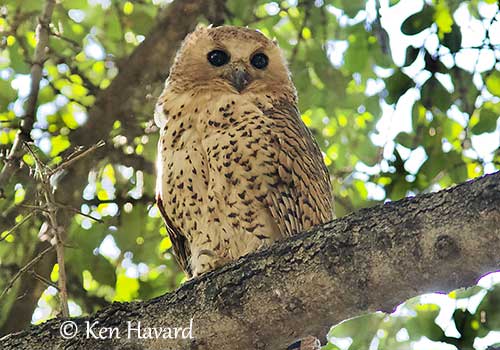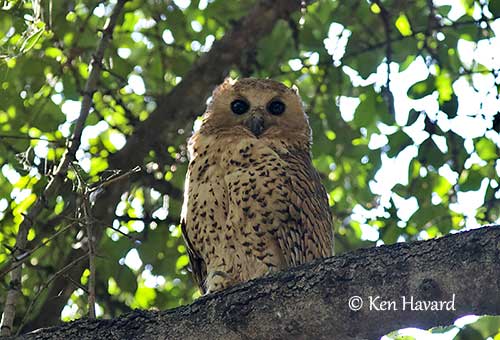
Fr: Chouette-pêcheuse de Pel
Ang: Pel's Fishing-Owl
All: Bindenfischeule
Esp: Cárabo Pescador Común
Ita: Gufo pescatore di Pel
Nd: Pels Visuil
Sd: afrikansk fiskuggla
Photographers:
Ken Havard
My Bird Gallery & Flickr gallery 1 & Flickr gallery 2
Jean-Claude Jamoulle
A la rencontre des Oiseaux
Text by Nicole Bouglouan
Sources:
HANDBOOK OF THE BIRDS OF THE WORLD Vol 5 by Josep del Hoyo-Andrew Elliott-Jordi Sargatal - Lynx Edicions - ISBN: 8487334253
OWLS OF THE WORLD – By Claus König, Friedhelm Weick and Jan-Hendrik Becking - IBSN 978-0-7136-6548-2
Owls of the World - A Photographic Guide: Second Edition – By Heimo Mikkola – Editeur: A&C Black, 2014 – ISBN: 147290592X, 9781472905925
Wildlife Act - Pel’s Fishing Owl (Scotopelia peli)
Biodiversity Explorer – The Web of Life in Southern Africa
Pel's Fishing Owl, Scotopelia peli, preying on a small crocodile
Wikipedia, the free encyclopaedia
Pel’s Fishing-Owl
Scotopelia peli
Strigiformes Order – Strigidae Family
INTRODUCTION:
The three species of genus Scotopelia are adapted for fishing, with powerful talons and long, curved claws.
The Pel’s Fishing-Owl is found in Africa, South of the Sahara, where it occurs along rivers, lakes, swamps and estuaries with forested edges. It feeds primarily on fish, but other aquatic prey are taken, such as frogs, crabs, freshwater mussels and sometimes large insects. It is mainly a nocturnal hunter, but it is sometimes observed by day, when the food becomes scarce. Like most Strigidae, the Pel’s Fishing-Owl is a cavity nester and usually nests in tree holes.
The Pel’s Fishing-Owl is described as common in most of the range, although habitat loss and cycles of drought may impact the lifestyle of this species. But it is not considered globally threatened for the moment.
The name of this species pays tribute to Hendrik Severinus Pel, a Dutch zoologist (1818-1876).

DESCRIPTION OF THE BIRD:
Biometrics:
Length: 51-61 cm
Wingspan: 153 cm
Weight: F: 2055-2325 g
The fishing-owls differ from eagle-owls by unfeathered toes and tarsi, spine-like scales on the soles of their feet, and indistinct facial disk. However, they share these morphological features with the Fish-owls of genus Ketupa.
The Pel’s Fishing-Owl is a large owl without ear-tufts. Head and upperparts are rufous-brown with fine dark barring, spotting and streaking. Flight-feathers and rectrices are barred dark.
On the underparts, the throat is white, whereas rest of underparts is pale rufous-buff with fine, dark streaks, becoming dark chevrons on flanks. Underwing-coverts and thighs are uniformly pale rufous.
On the head, the facial disk is inconspicuous, mostly rufous-brown with indistinct rim. Feathers of both head and nape are long, often loose, giving the head a tousled appearance. The ear-tufts are absent.
The bill is black with grey base. The cere is grey. The eyes are dark brown to blackish. Bare tarsi and feet are straw-coloured.
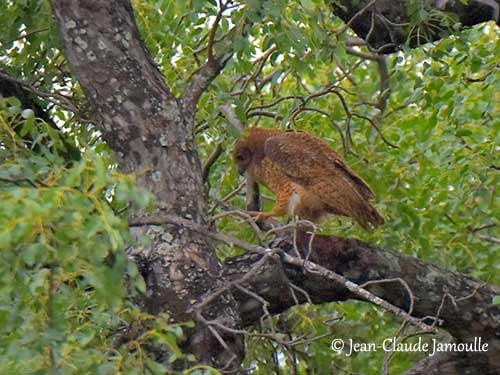
Male and female are almost similar, although the female is often less rufous than male.
But there can be quite a noticeable variation in plumage colour.
The juvenile has whitish head and body with rufous wash. It is similar to adult at 15 months old.
The chick is covered in white down.
RANGE:
The Pel’s Fishing-Owl is found in various countries in Africa, from Mali and Nigeria to Senegambia, Sierra Leone, Liberia, Guinea and Ghana. It also occurs in C Africa from the coast, E to eastern Congo, and to Sudan, Somalia, Kenya and Tanzania, and from Congo patchily S to Zimbabwe, Botswana and E South Africa.
HABITAT:
The Pel’s Fishing-Owl frequents forests and woodlands close to abundant water source such as swamps, dams, rivers, lakes and estuaries, from sea-level up to 1,700 metres of elevation. It favours riverine forests with large trees, also islands in large rivers or thickets of matures trees in lakes or swamps, but not too far from the bank.
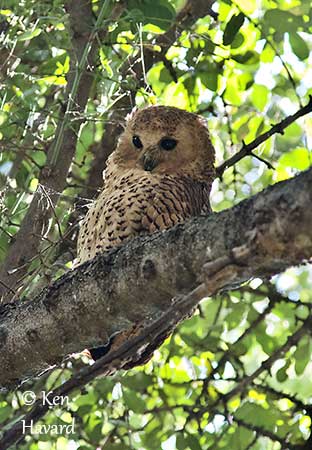
CALLS AND SONGS: SOUNDS BY XENO-CANTO
The Pel’s Fishing-Owl adult male gives a deep, loud, horn-like boom including a hoot followed by a deeper, softer grunt, described as “whoommmm-wot”. This sound is usually heard from a distance, up to 3 kilometres away.
The female’s call is slightly higher-pitched with a double note at the end.
The phrases of this song are repeated roughly every ten seconds. When the male is singing, the feathers of throat and upper breast are well inflated.
Other sounds can be heard during the nesting period if an intruder approaches the nest. Both mates produce penetrating trills while performing distraction displays, usually feigning an injury.
BEHAVIOUR IN THE WILD:
The Pel’s Fishing-Owl feeds almost exclusively on fish of 100-200 grams, occasionally up to the weight of 2 kg. But frogs, crabs, freshwater mussels and large insect are also part of the diet.
It hunts from low perches, often branches overhanging the water from which it surveys the surrounding. The fish is detected by the ripples on the water surface. The owl glides down and rapidly dives in flight with talons outstretched to catch the prey, before returning to its perch to feed. Immersion of the body by dashing into the water may occur, but very rarely. It may also forage by flying low to catch the fish like Fish-eagles, or by wading into shallow water close to sand banks.
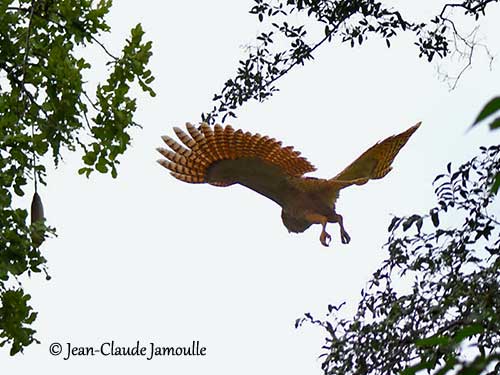
From an observation on 20 July 2001 in Zambia, a Pel’s Fishing-Owl was perched about 7 metres above the ground, grasping in one foot a small Nile Crocodile. The prey was draped across the branch with a bloody gash on the neck side where the owl was feeding. It was roughly equivalent to the length of the owl, about 55 centimetres. When the owl flew away, the crocodile was dangling from one set of talons, carried by this powerful owl.
The Pel’s Fishing-Owl is usually nocturnal, sometimes feeding by day when the food resources become scarce. However, it often roosts on large branches during the day, with male and female close to each other. They leave the roost at dusk and perch over the water on branches or stumps.
The Pel’s Fishing-Owl breeds during the dry season. They are monogamous. The territory is close to the water and both mates gives intensive hooting to claim it, mainly at the beginning of the breeding season.
Courtship involves duets of grunting and hooting notes by both mates from a branch. They nest in cavities in old trees or other natural hollows.
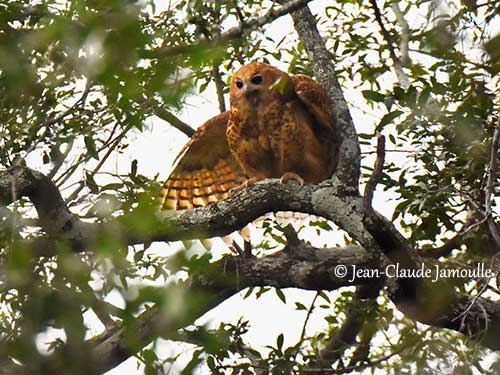
The Pel’s Fishing-Owl is resident with some local movements probably related to seasonal fluctuations of water levels.
Most Strigidae have silent flight allowing them to hunt at night. But here, because the fish cannot hear the approaching owl, the feathers of the fishing-owls do not need to be smoothly tipped to make the flight silent. The wings are rounded but the flight is powerful.
REPRODUCTION OF THIS SPECIES:
The Pel’s Fishing-Owl breeds during the dry season, once the water’s level is low and the prey more concentrated. They breed once every two years.
The territory is established along a stretch of river or on lake shore, and both adults defend it. They nest in natural hollow, a cavity or a hole in old shady tree close to the water. They do not add soft material to the nest.
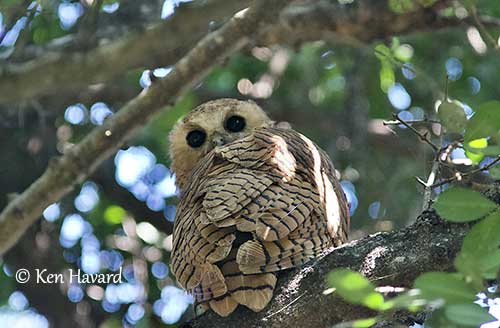
The female lays 1-2 white eggs on the bottom of the nest. She incubates alone during 30-32 days, but she is fed by the male during this period.
The chicks may hatch up to 5 days apart. At hatching, they weigh 60-70 grams, and at 7 days old, they open their eyes. At 20 days, the weight is 500 grams, and when fledging at 68-70 days, they weigh 1,400-1,700 grams. But the second chick does not survive and disappears, probably from starving.
The young owl remains in the parental territory during 6-9 months after fledging, involving breeding only every two years.
When the female is disturbed or threatened at nest, she usually performs distraction displays while uttering high trills and feigning injury. She may attack the African-fish Eagle coming too close to the nest.
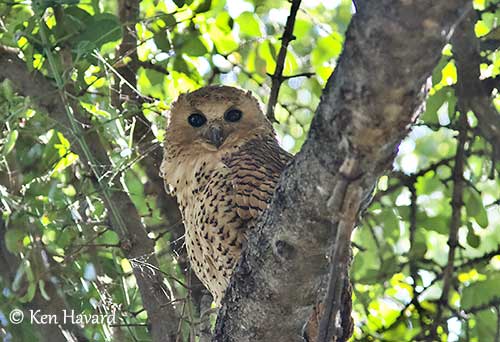
PROTECTION / THREATS / STATUS:
The Pel’s Fishing-Owl is rather common locally, although it is scattered in most of the range.
It is affected by water pollution and fluctuations of water levels, cycles of drought and habitat loss depending on the range.
The population size is unknown, but it is suspected to be slowly declining, mainly due to habitat loss.
But the species is not globally threatened, and the Pel’s Fishing-Owl is currently evaluated as Least Concern.
